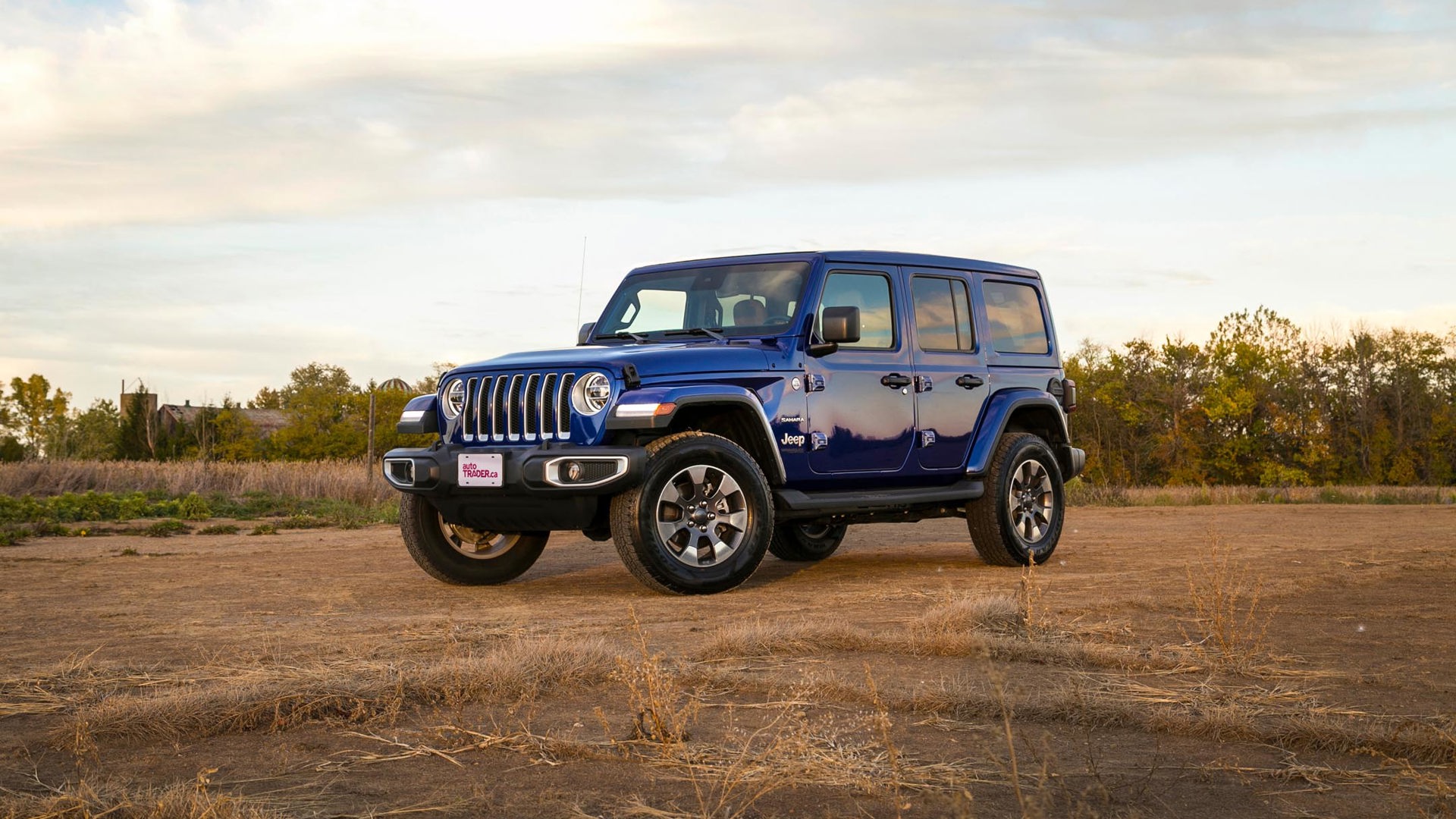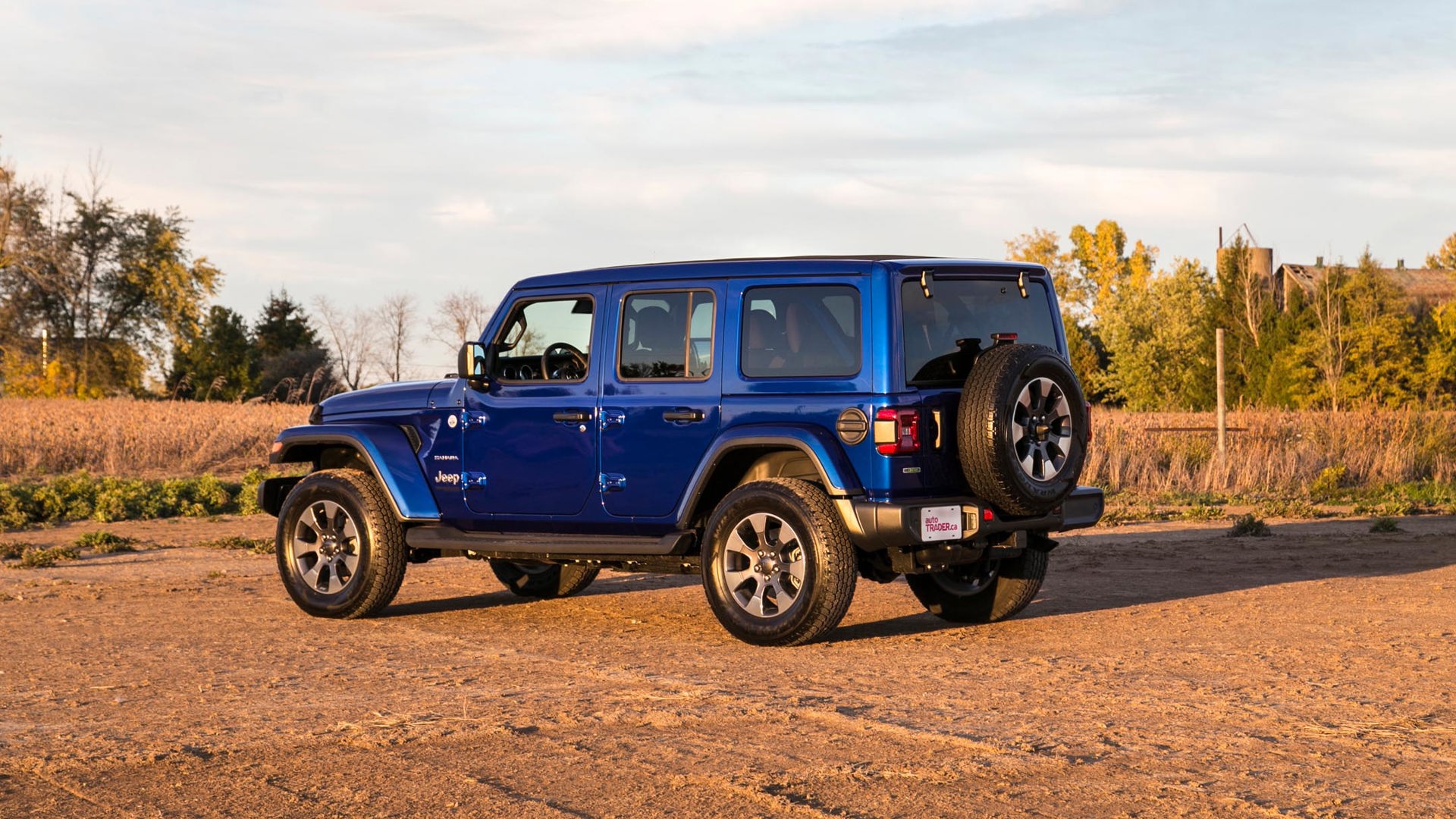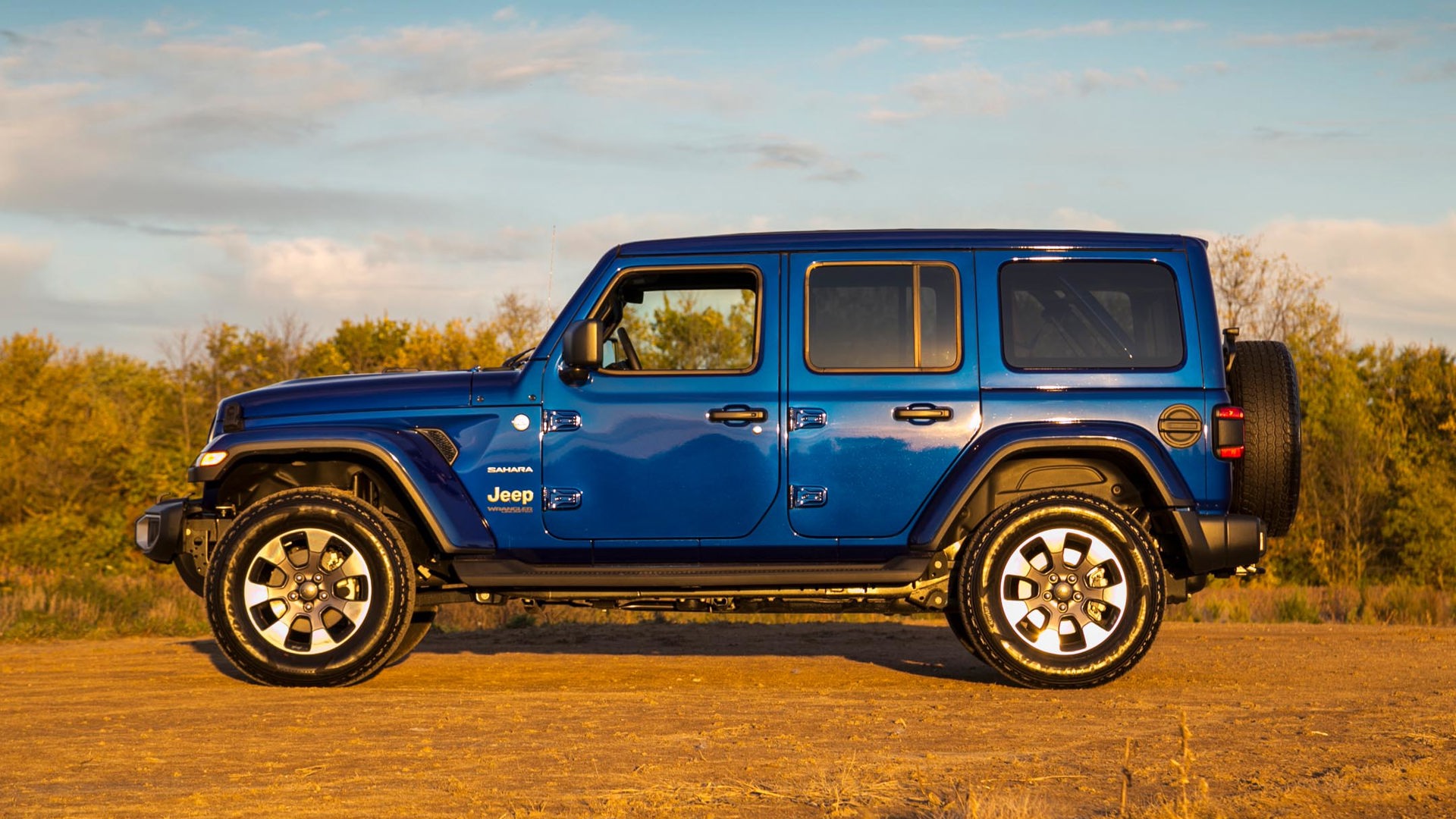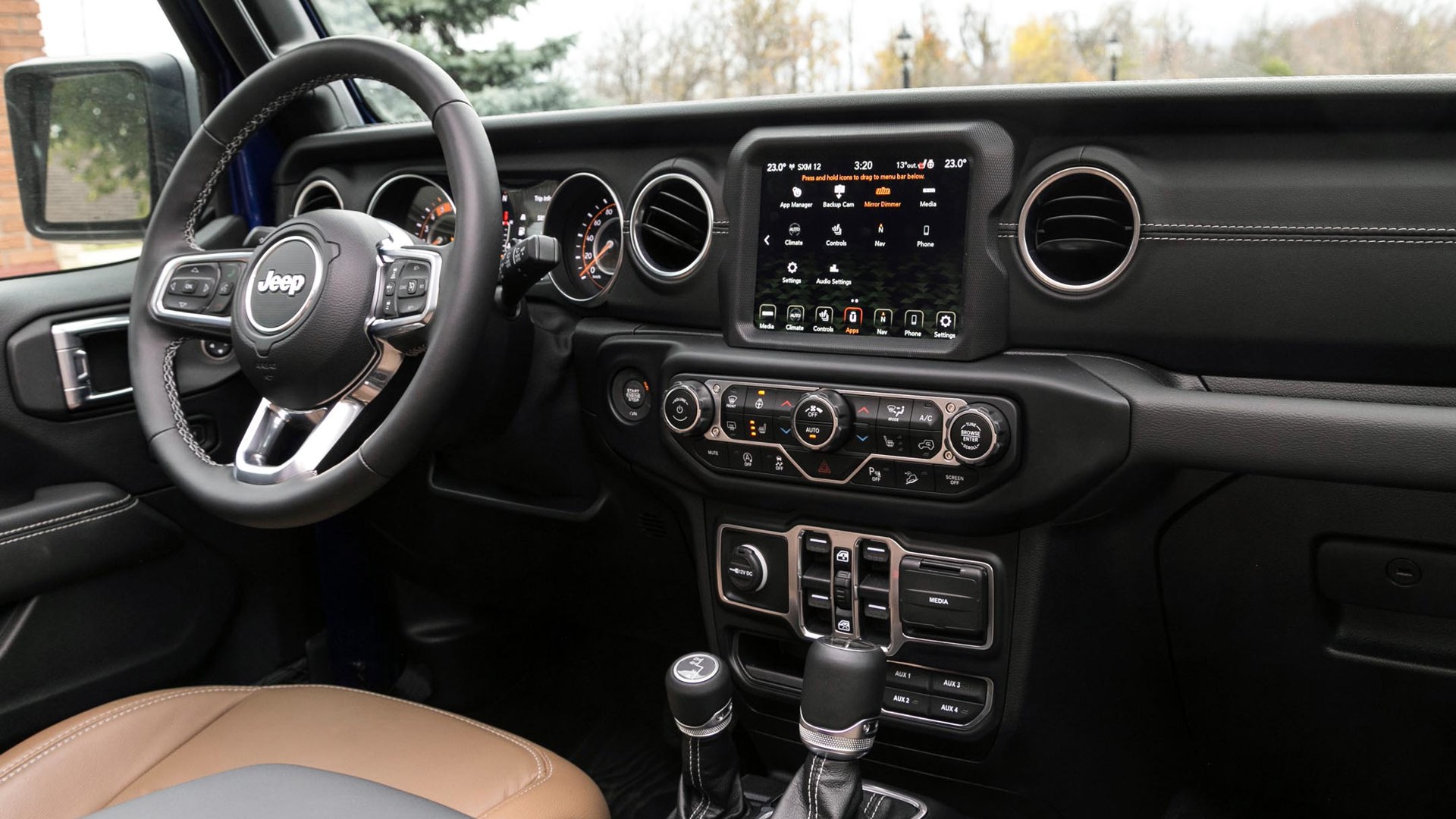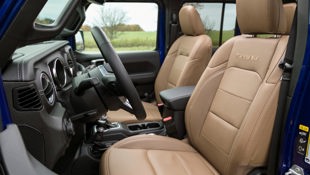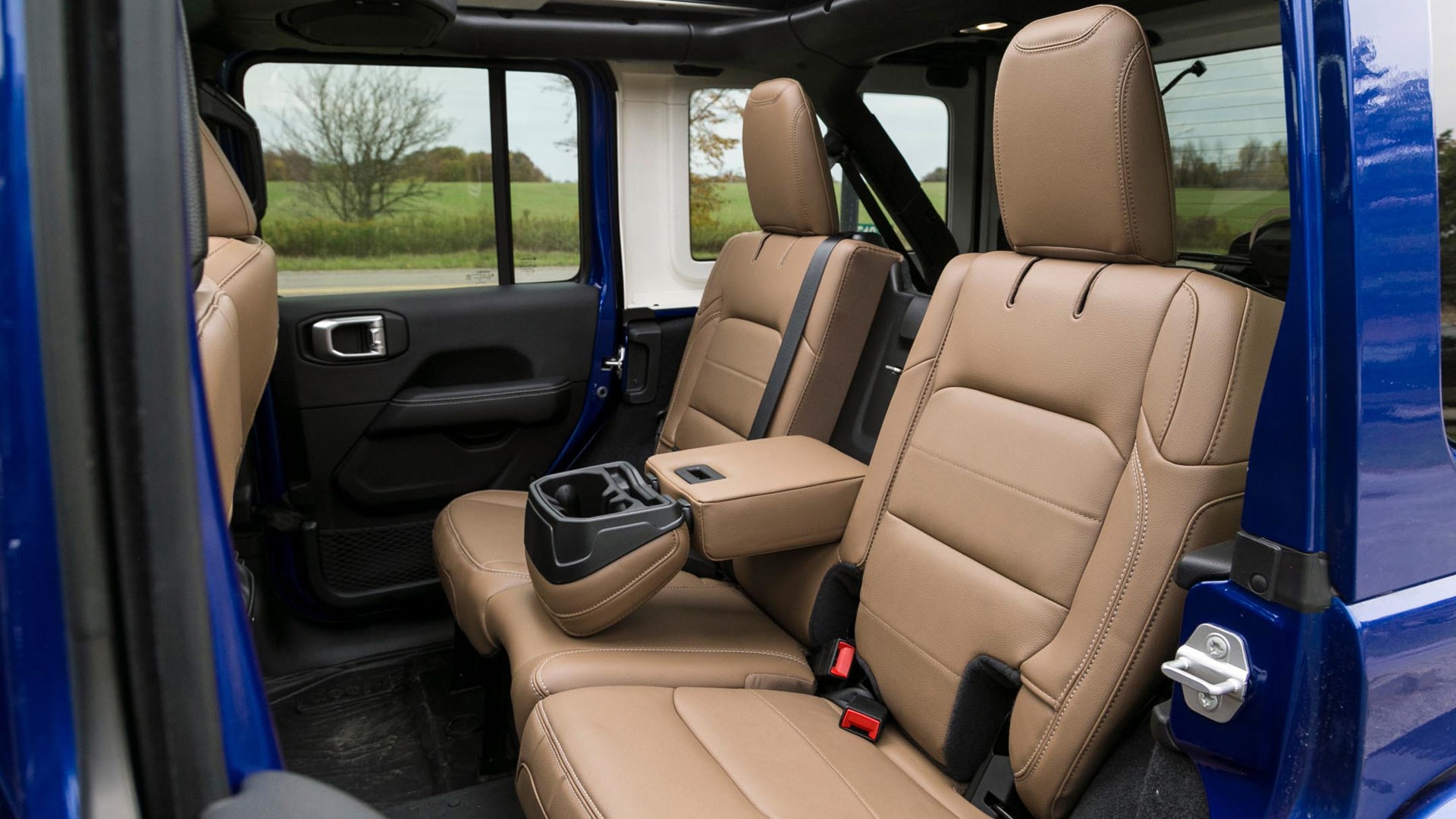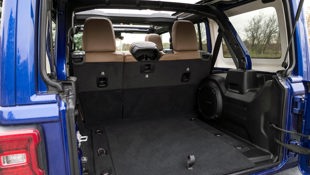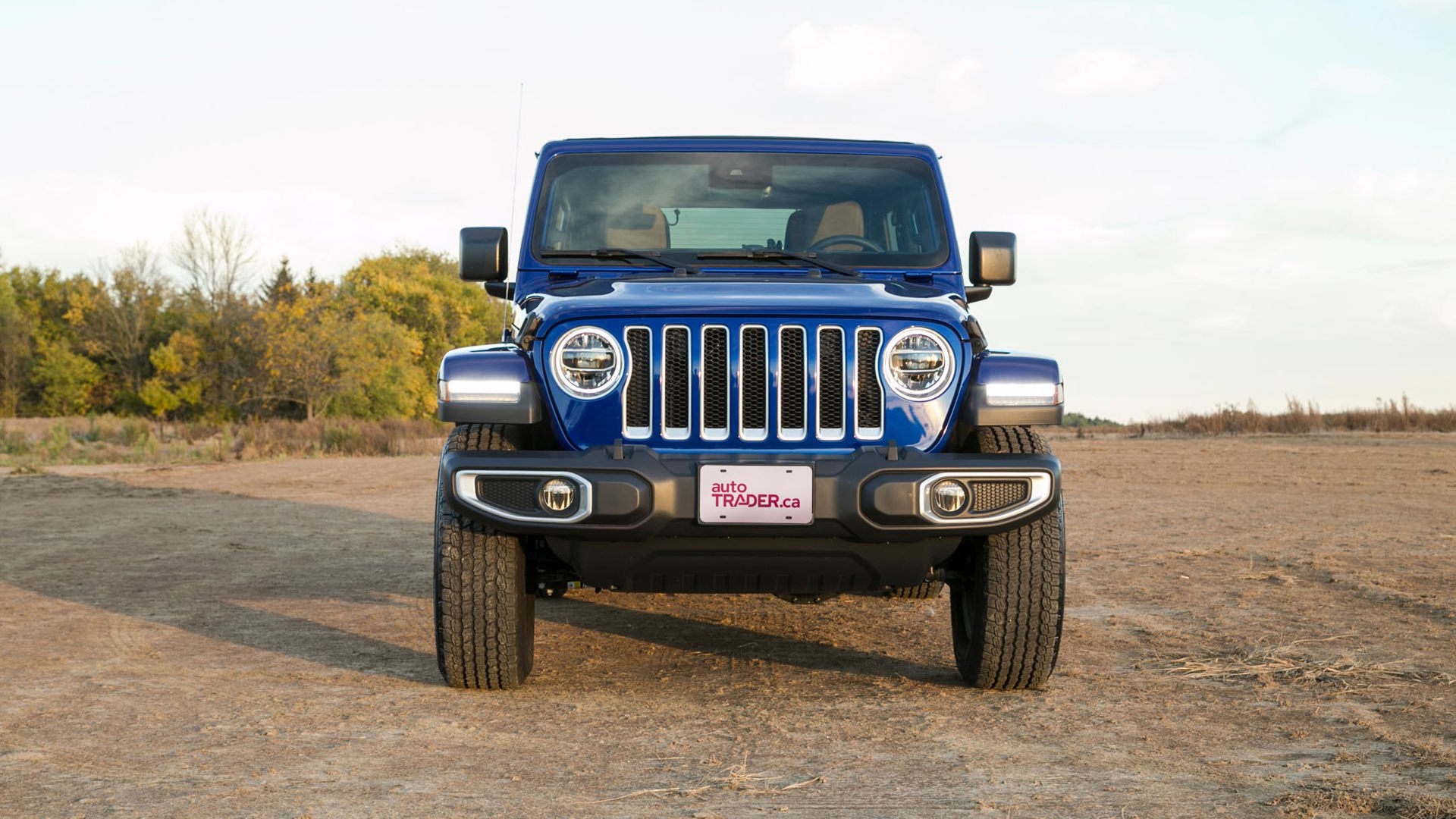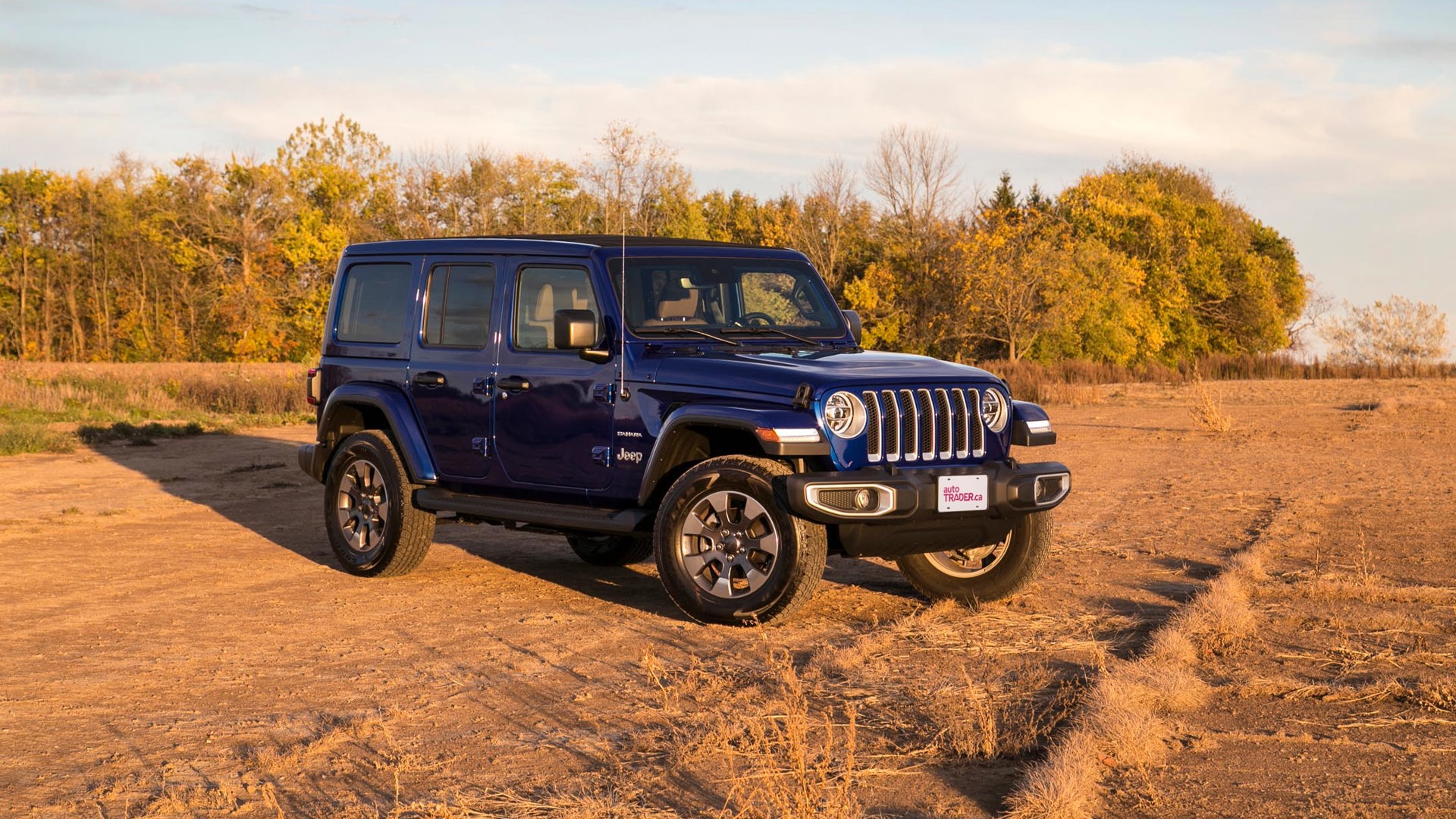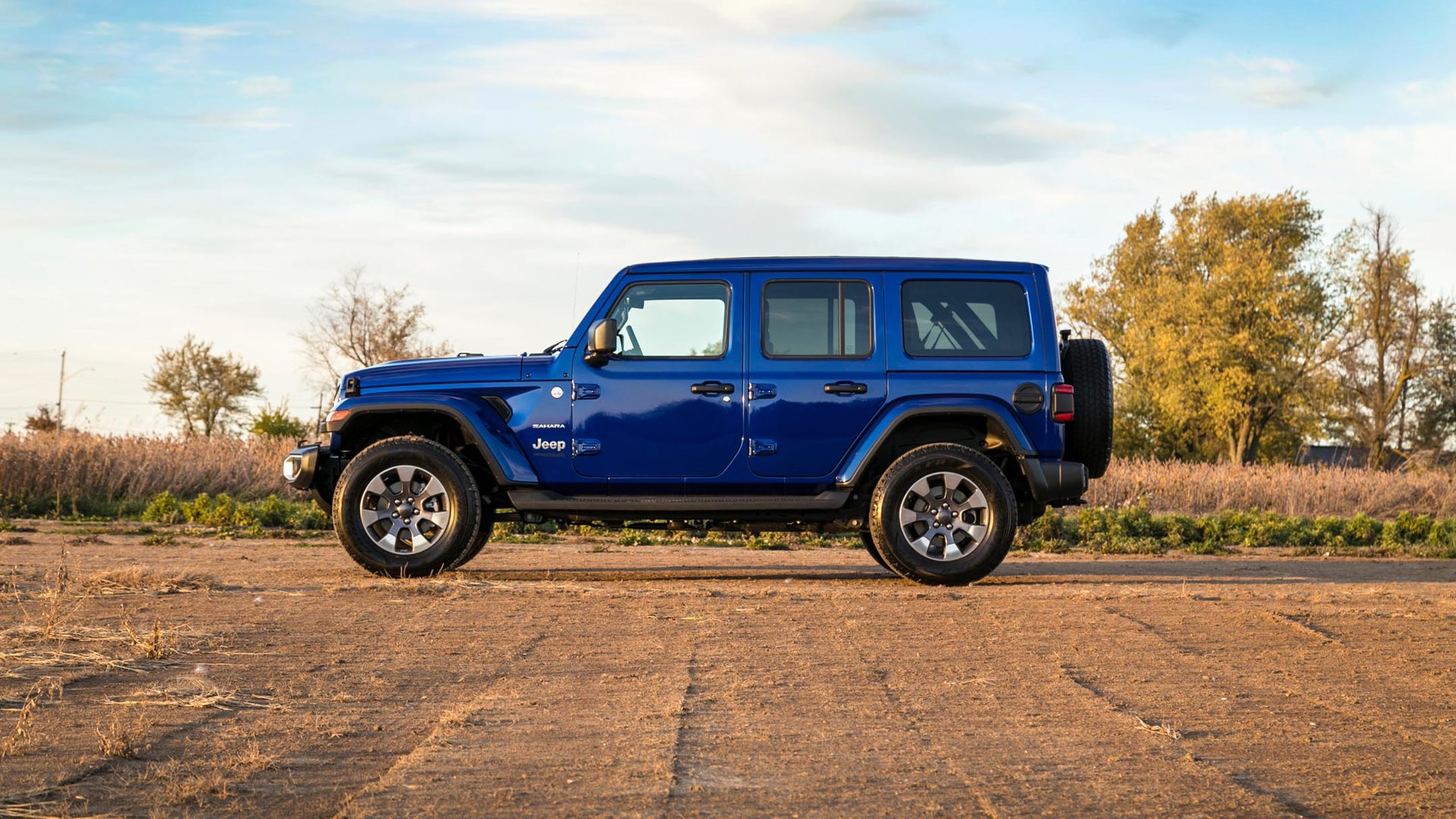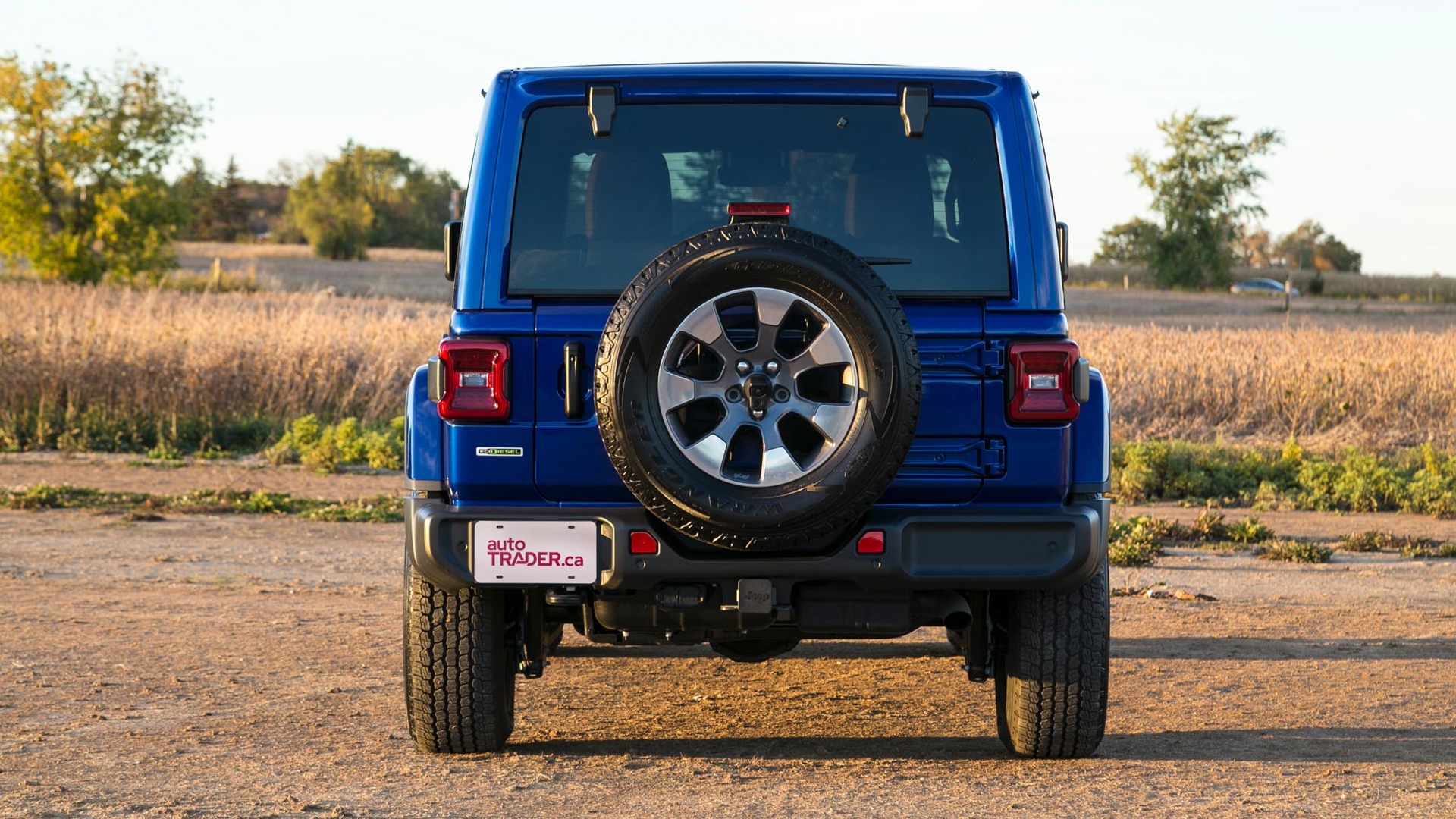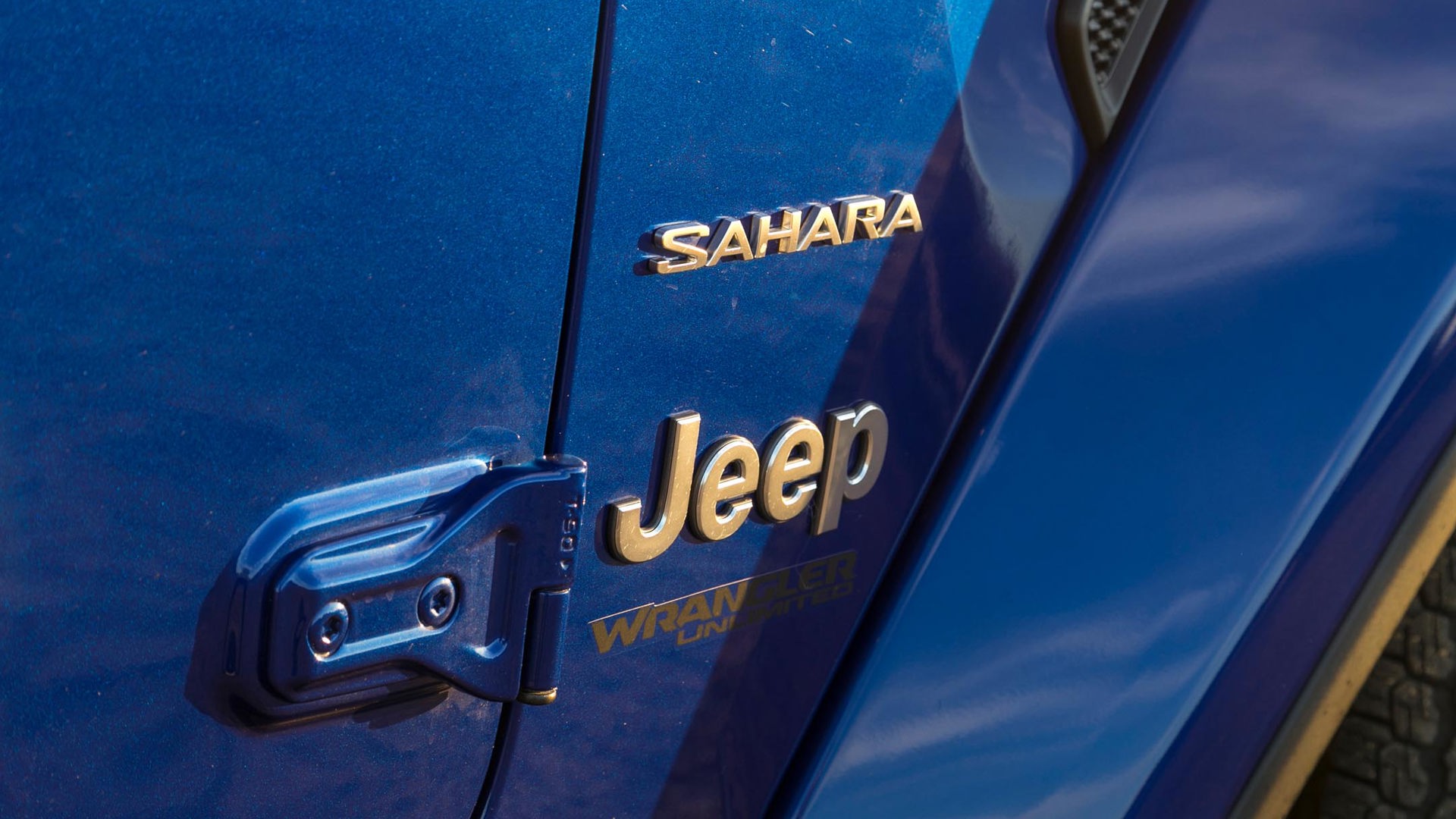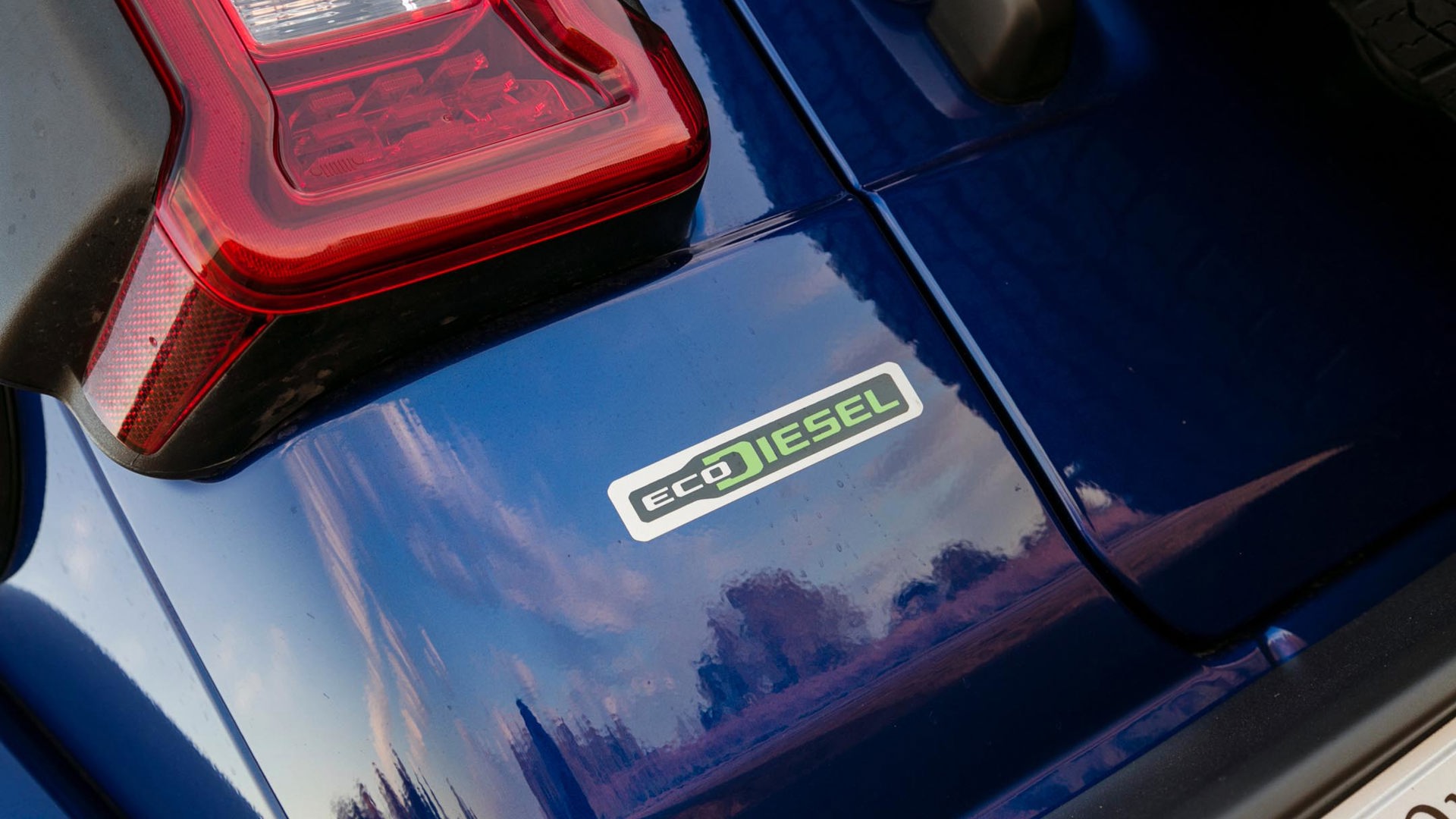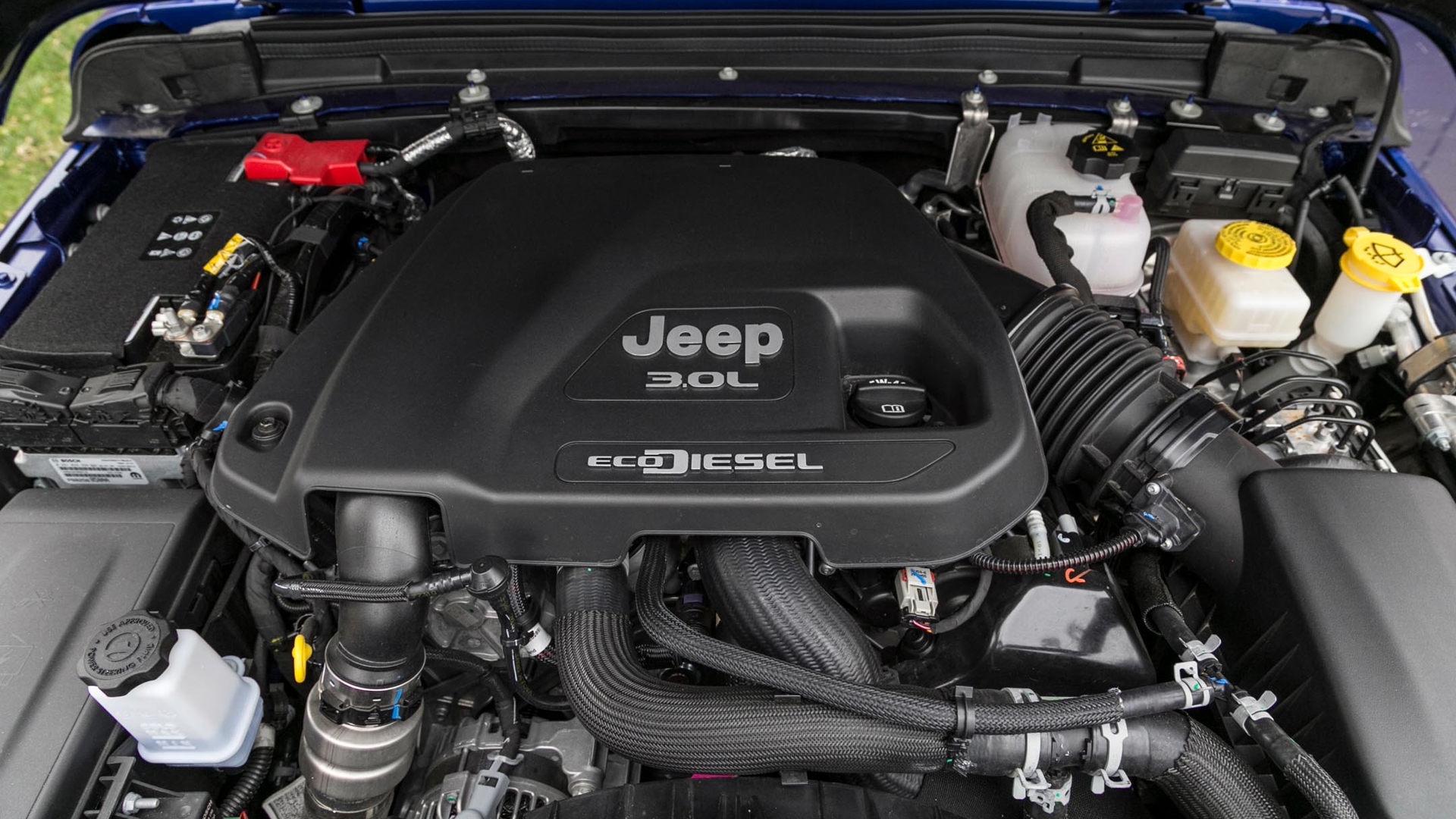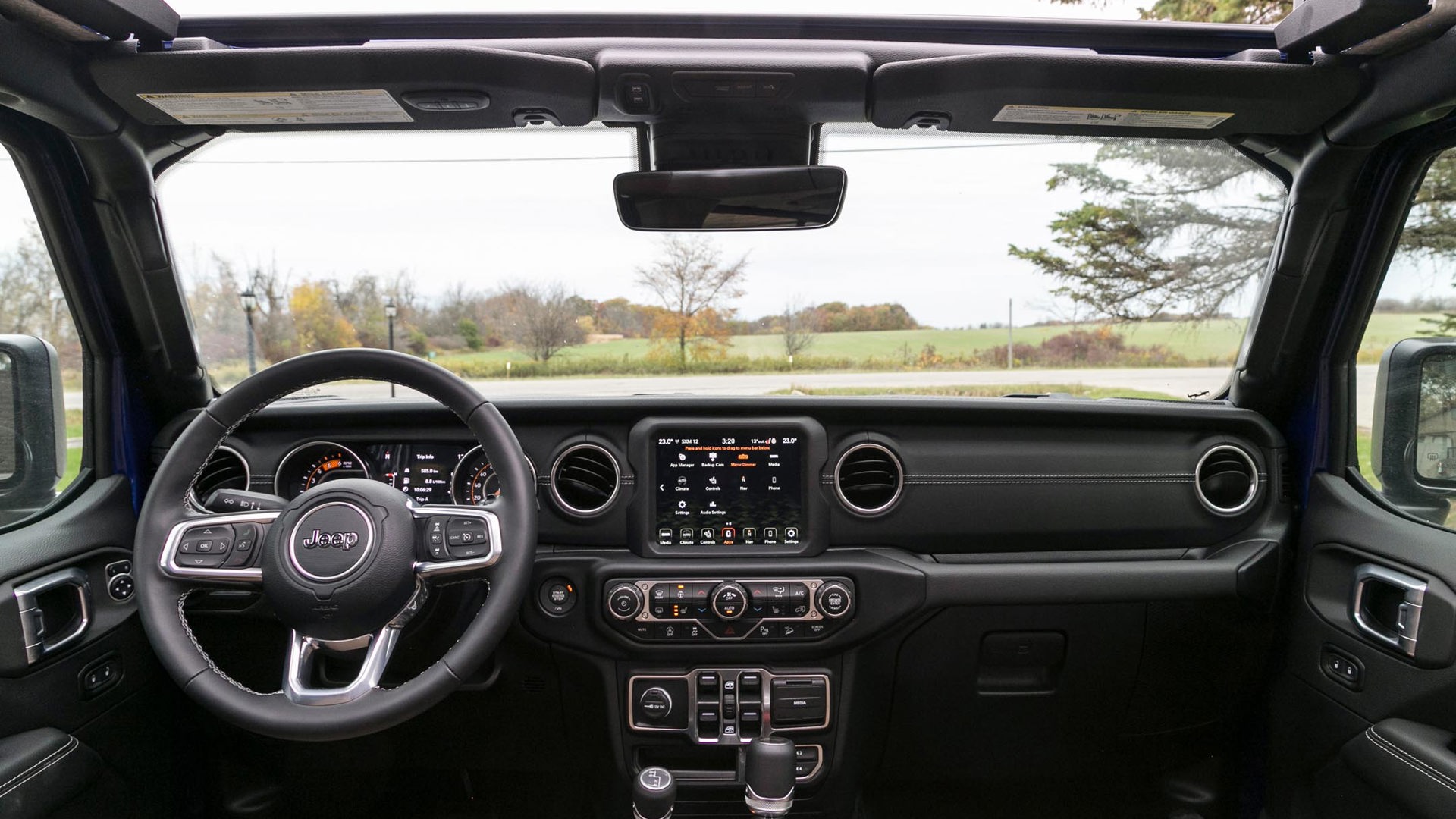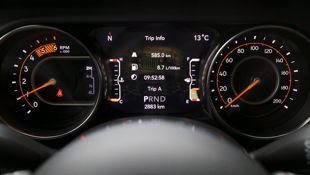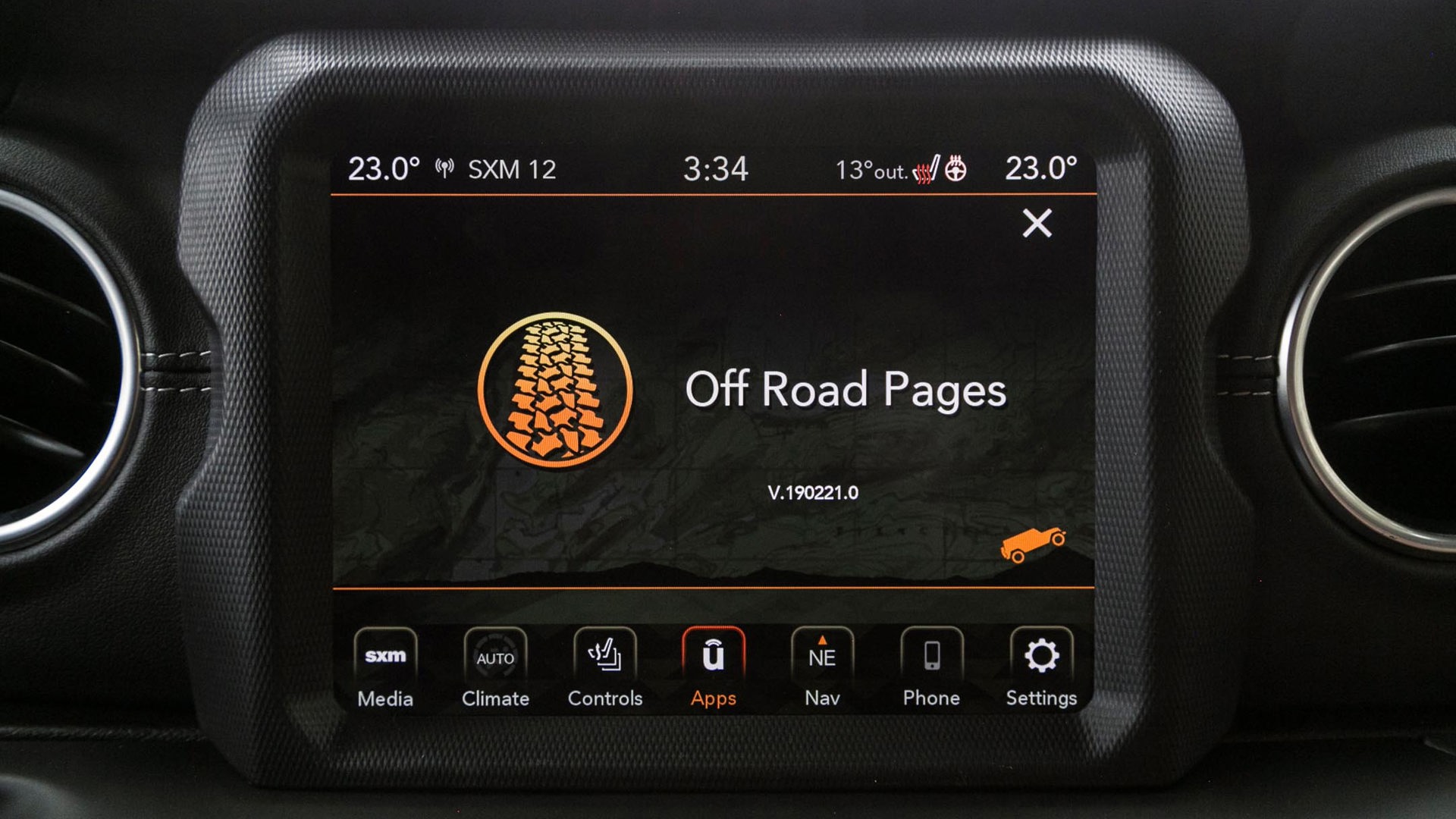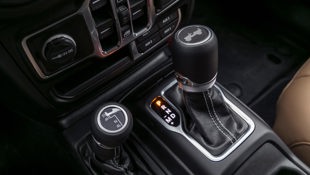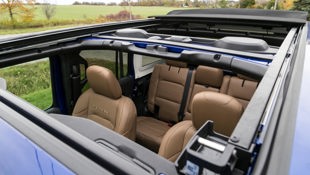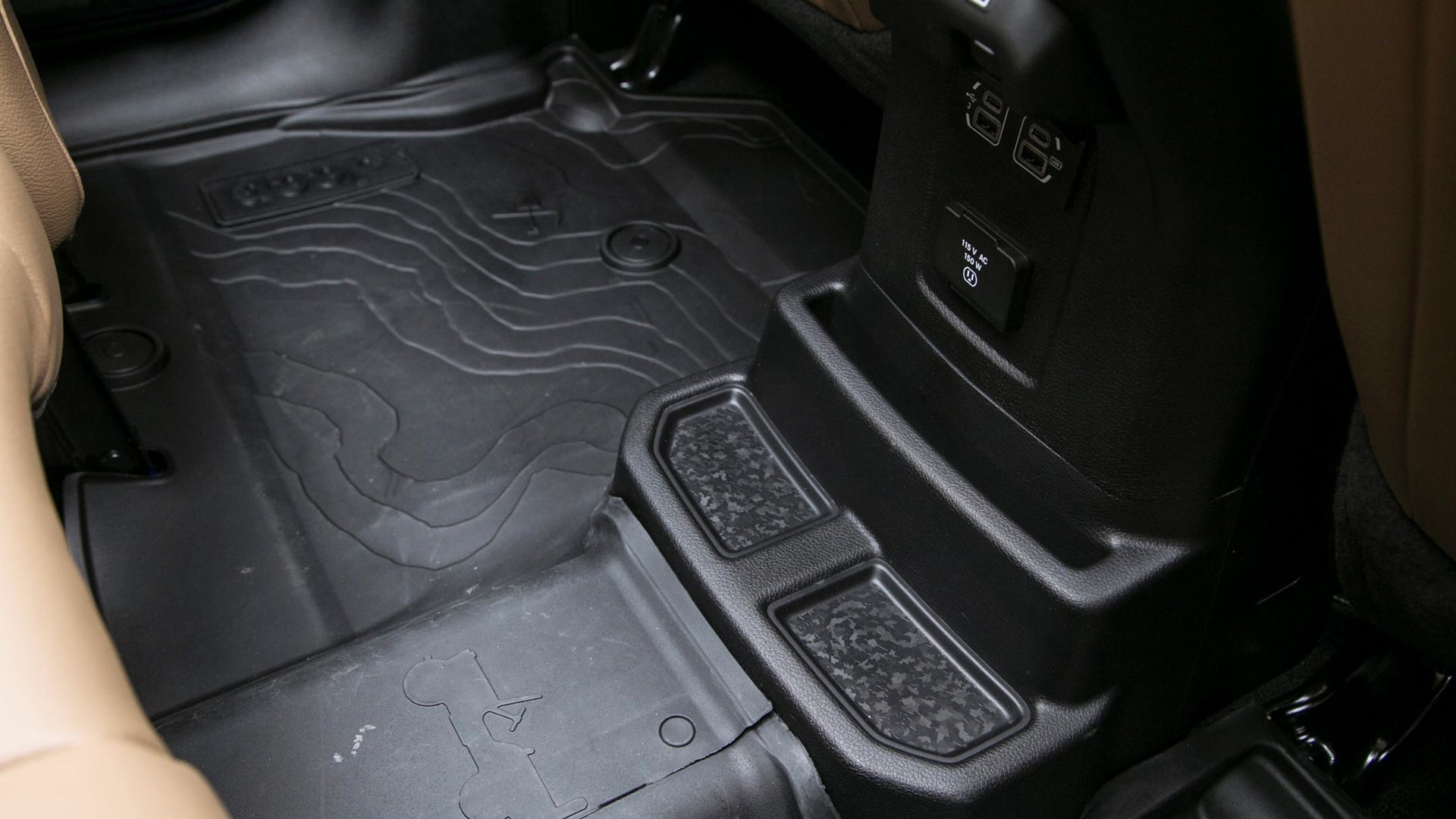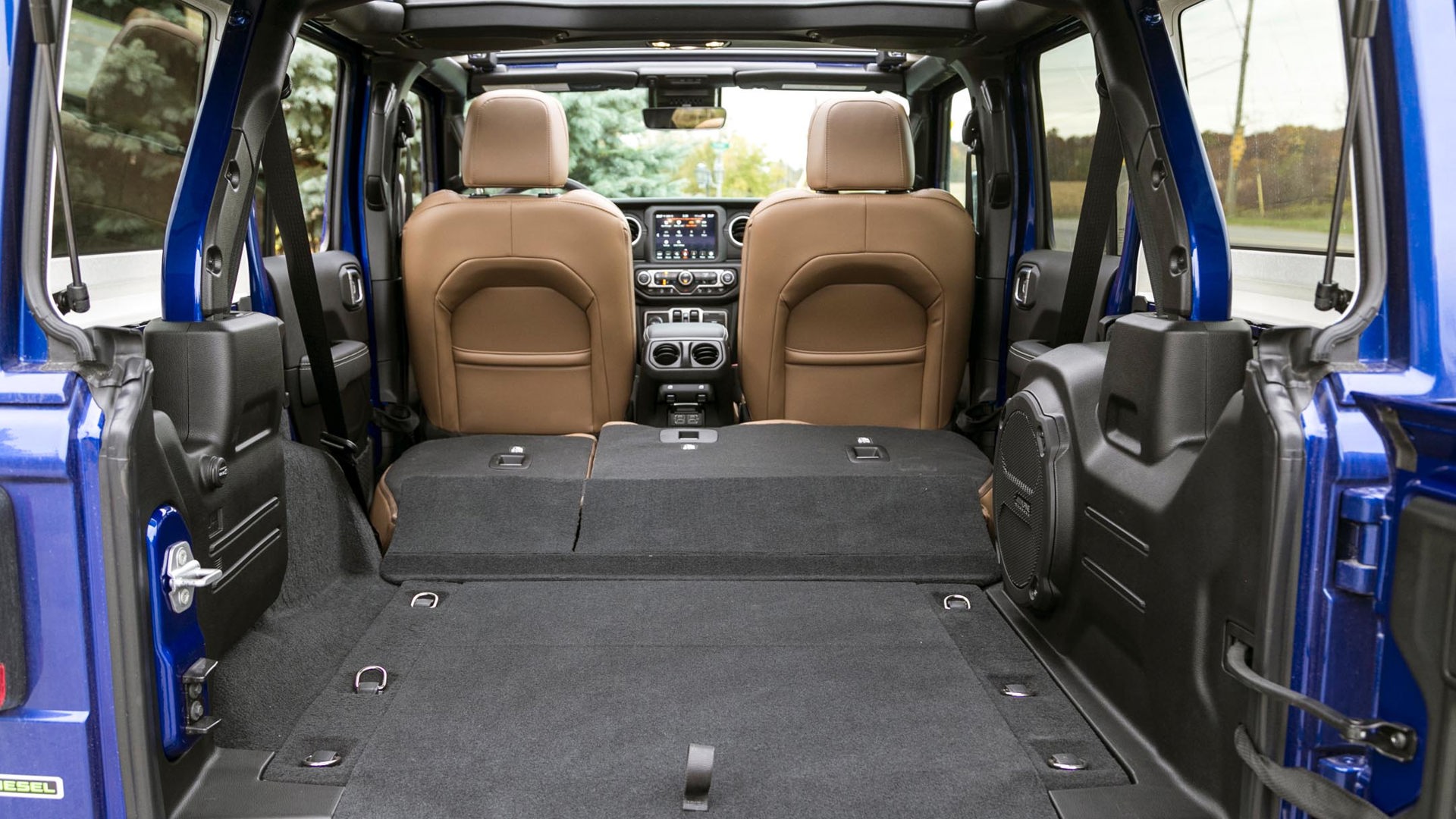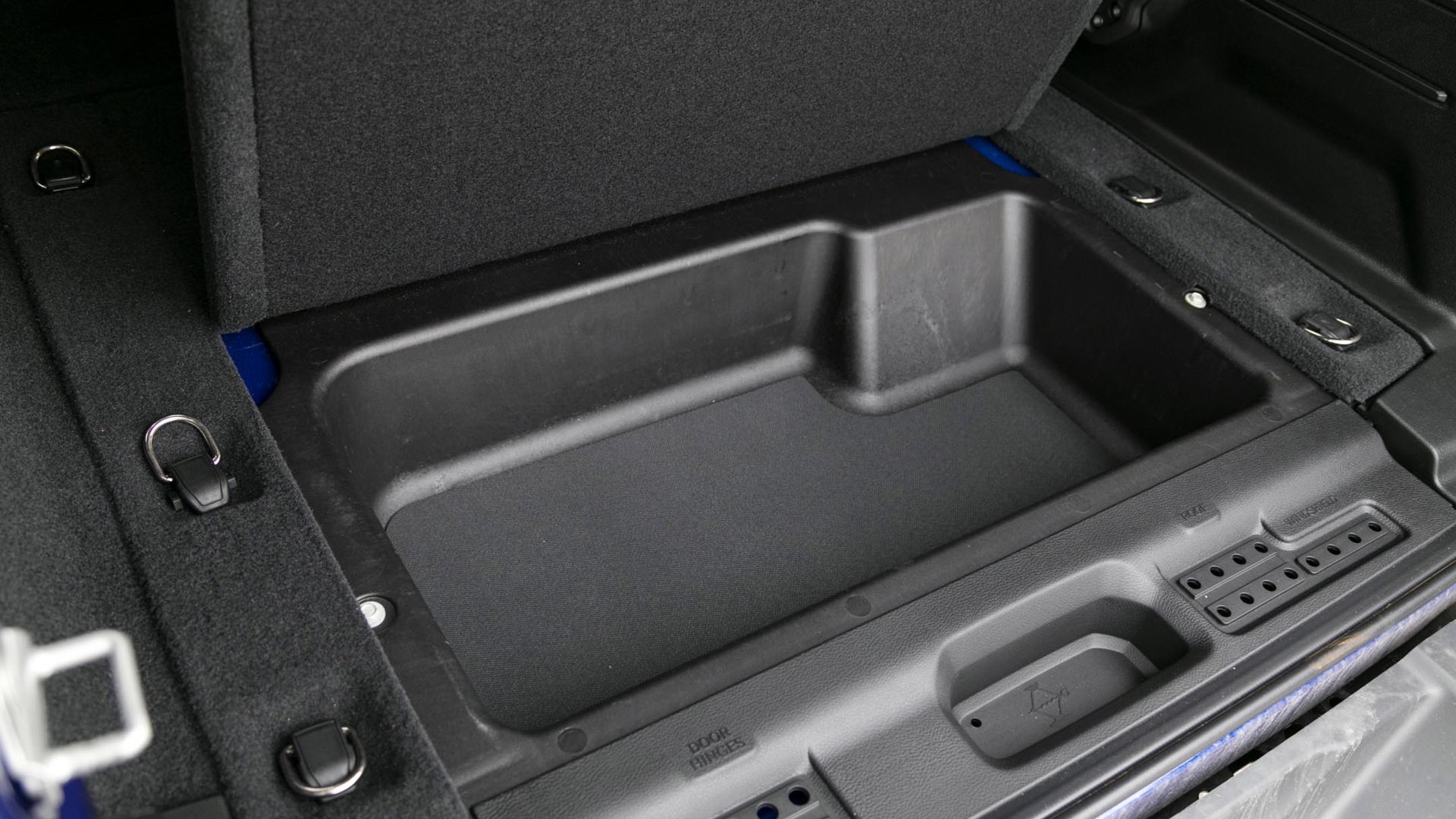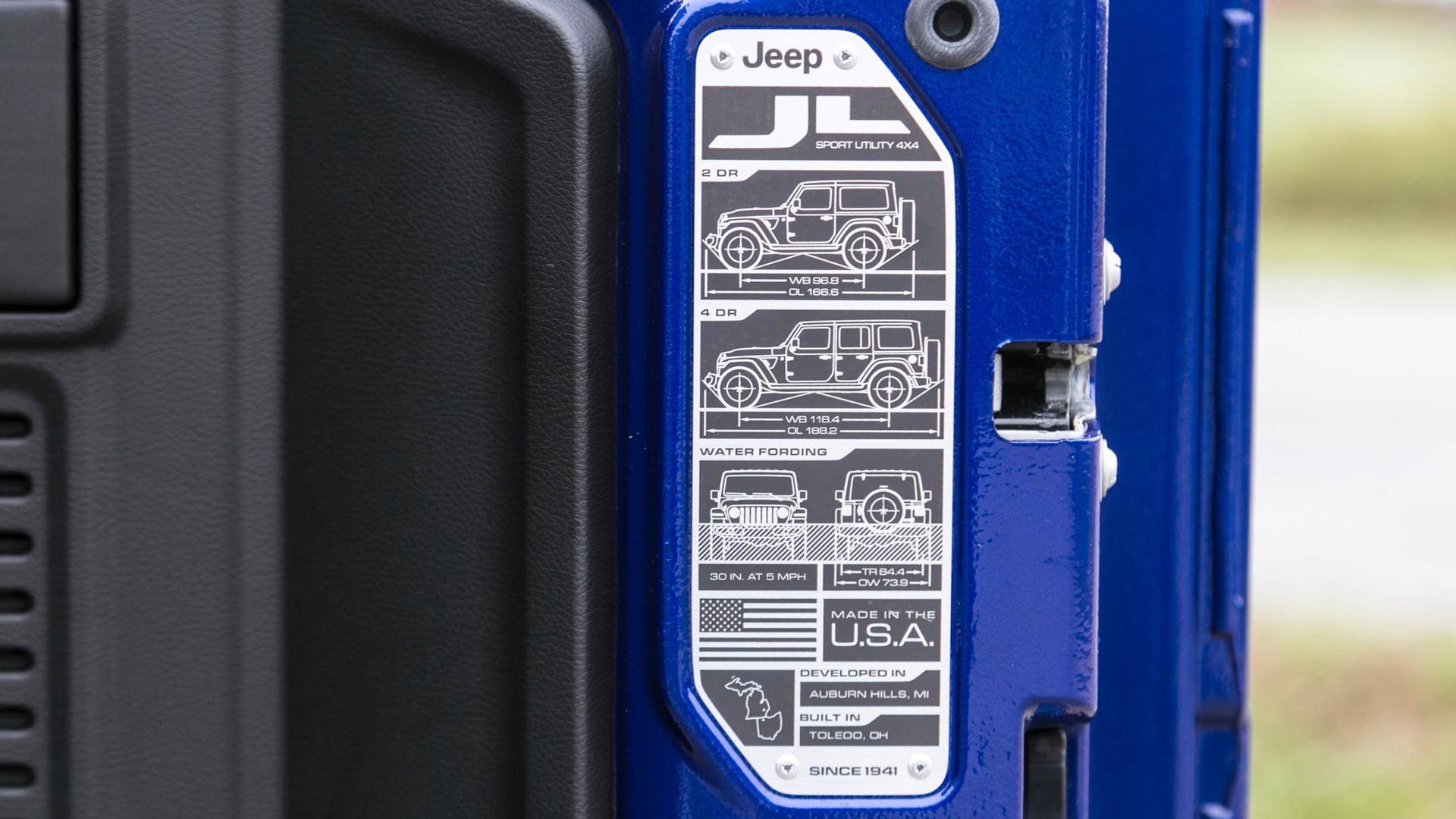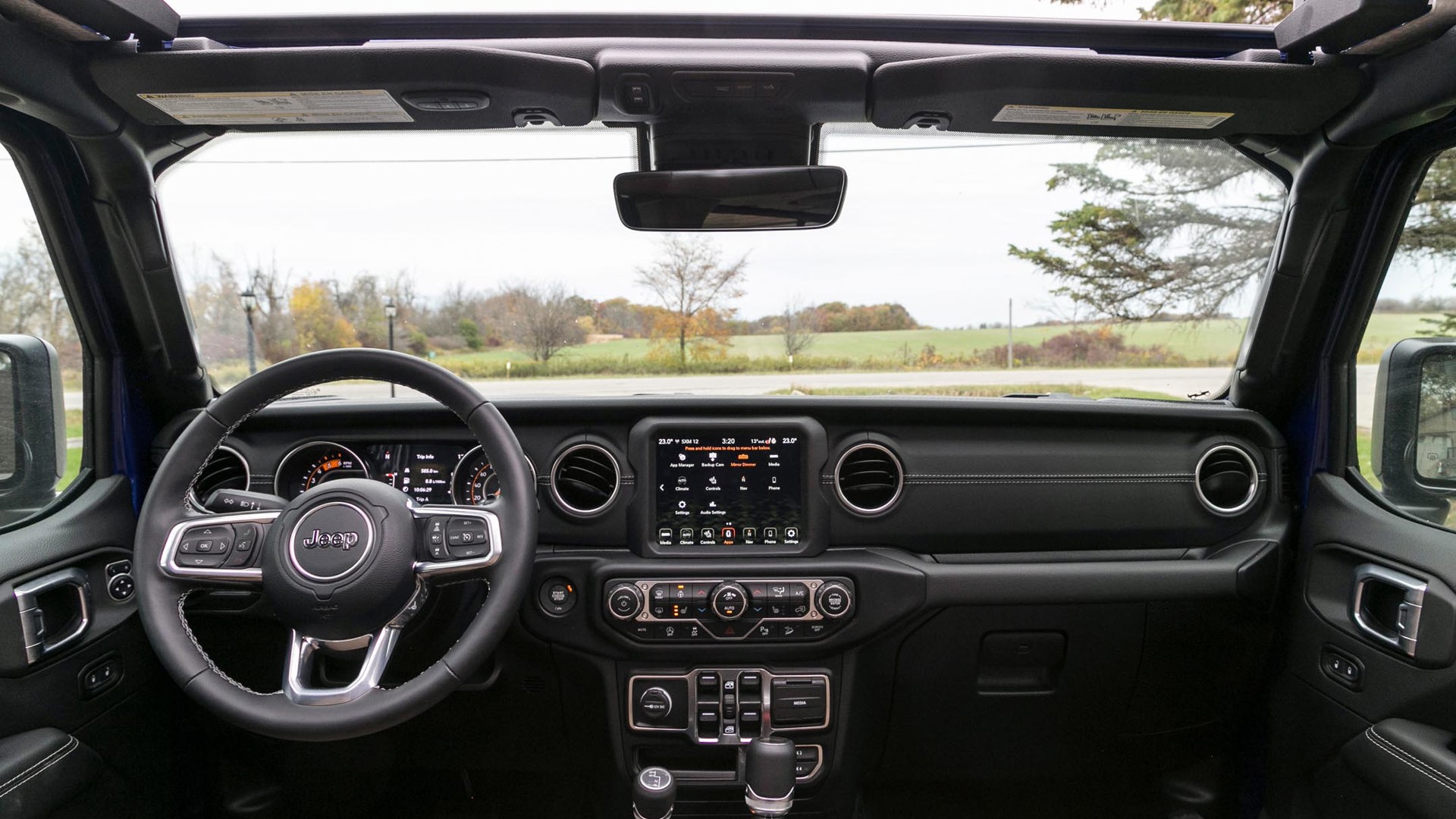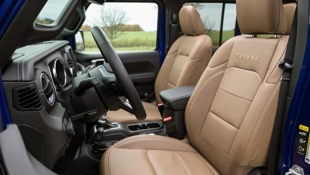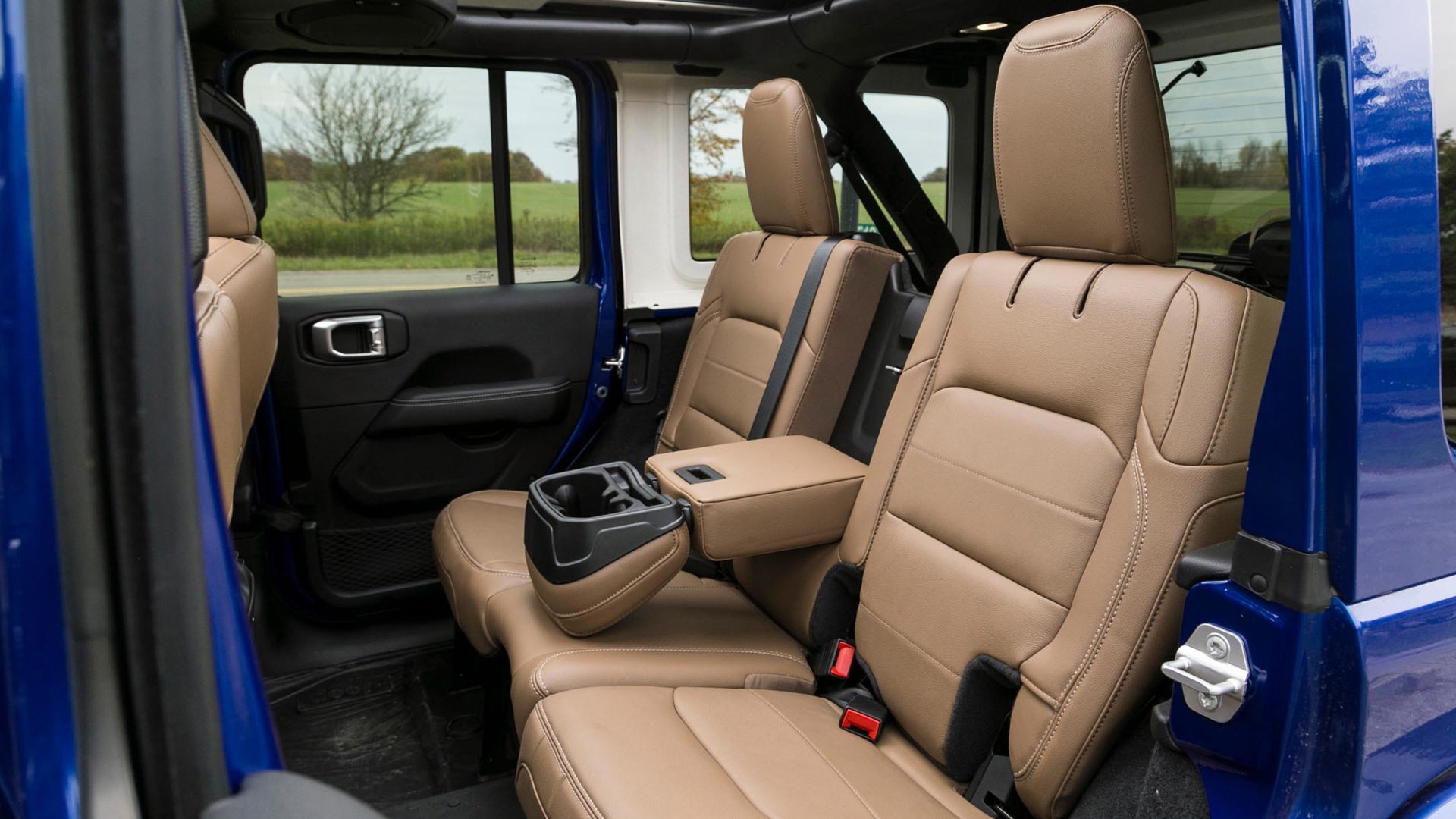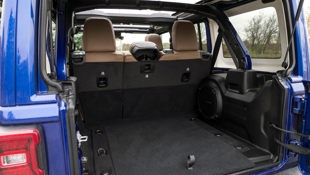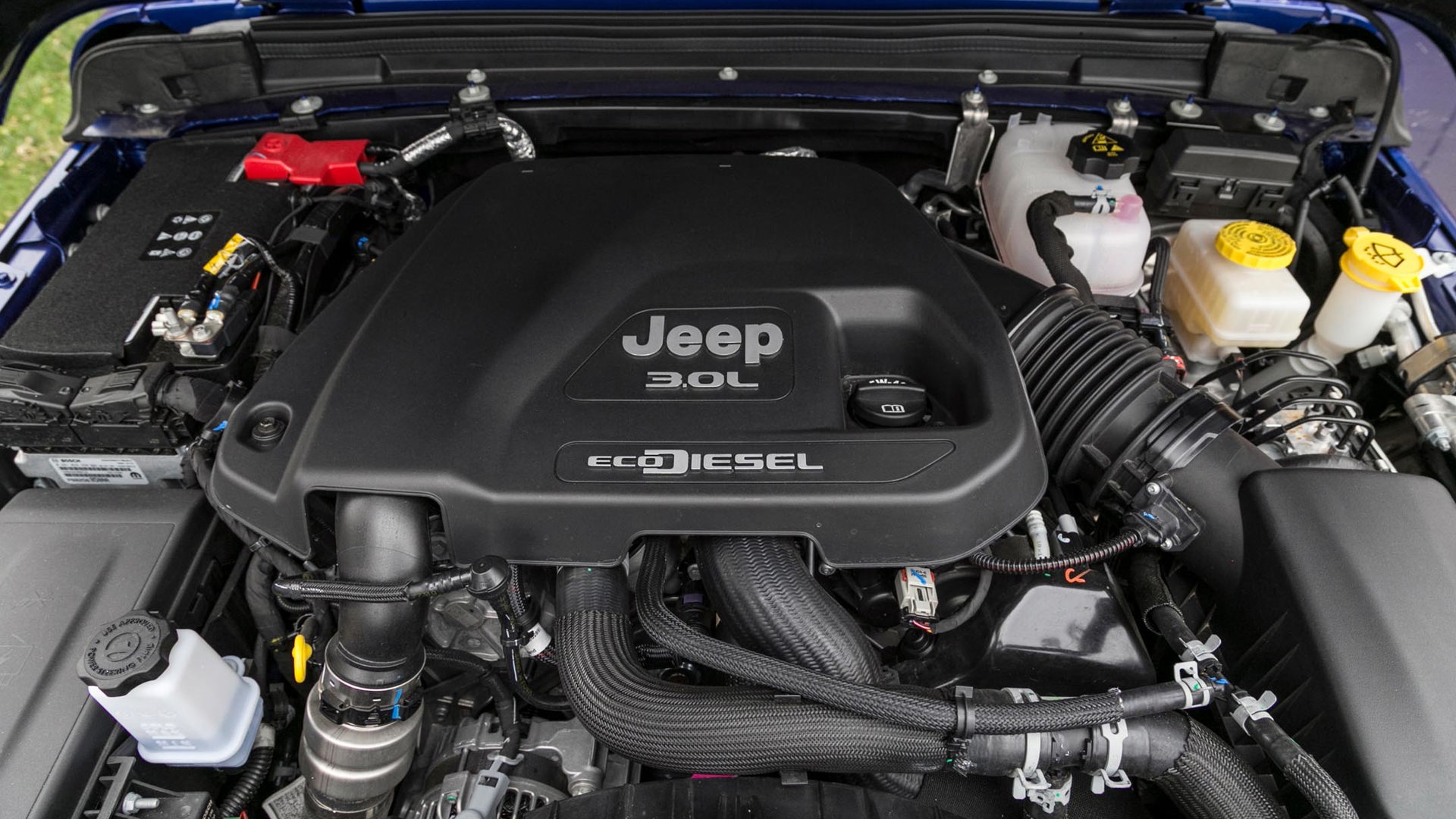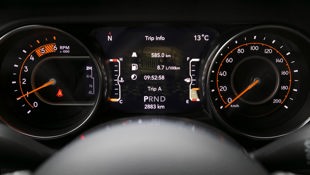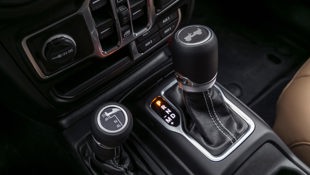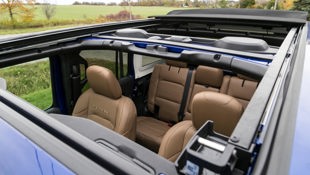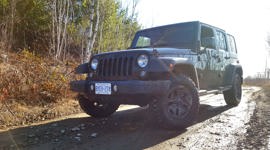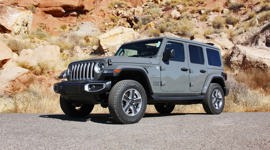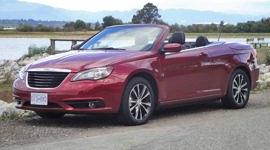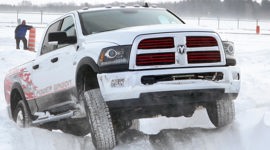 AutoTrader SCORE
AutoTrader SCORE
-
STYLING7/10
-
Safety6/10
-
PRACTICALITY7/10
-
USER-FRIENDLINESS8/10
-
FEATURES7/10
-
POWER7/10
-
COMFORT6/10
-
DRIVING FEEL7/10
-
FUEL ECONOMY8/10
-
VALUE7/10
Coinciding nicely with the official unveiling of the reborn Ford Bronco, Jeep showed off a Wrangler concept with a 6.4L V8 stuffed under the hood. Unsurprisingly, the Jeep faithful hooted with approval.
The promise of an extra wallop of torque is enough to get any gearhead excited, whether it’s for the street, the track, or even the trail. But let’s be real: a bigger, heavier V8 that makes the Wrangler accelerate with ferocity is a fun though not fully sane idea, and whether the big engine will ever make it into series production remains to be seen.
Still, a powerplant with low-end torque works really well off-road, and a trail rig could always benefit from more torque. Enter the 2020 Jeep Wrangler EcoDiesel.
Fuel Economy: 8/10
Yes, having extra oomph is nice, but so is having more money in your pocket, and the diesel isn’t just efficient by Wrangler standards – it’s properly frugal for any midsize SUV, let alone one that’s so capable off-road. The diesel-powered Wrangler gets a government rating of 10.6 L/100 km for city driving, which is better than the highway rating of the 3.6L gas-powered model. More impressive still are the diesel Wrangler’s highway (8.1 L/100 km) and combined (9.5 L/100 km) ratings.
What’s more, the diesel Wrangler achieves its thriftiness with minimal help from the driver. During a week of driving mostly in traffic on the highway and around town, our test Wrangler still knocked off an average in the mid-8.0 L/100 km range.
Value: 7/10
It wouldn’t be hard to achieve a consistent 3.0–3.5 L/100 km improvement over the V6 Wrangler in normal driving. For someone covering 25,000 km annually, the diesel should save roughly $850–875 per year in fuel costs.
That’s no small sum, but neither is the cost of the diesel engine option in the first place, which adds an eye-watering $7,395 to the bottom line. That means it’ll take a decade of driving before the fuel savings catch up to the cost of the option. You’ll also need to budget for periodic top-ups of the diesel exhaust fluid (DEF) as well.
Of course, the benefits of the diesel engine go beyond efficiency, but Wranglers aren’t exactly cheap to begin with. This one, optioned up as it is, totals more $70,000 before tax. Still, when compared to its closest competitors in the Toyota 4Runner, Ford Bronco, and Land Rover Defender, the Jeep is at least competitively priced. The Wrangler also holds its value, making it a decent lease choice, and consistently retains high resale value.
Power: 7.5/10
For years, other parts of the planet have received Wranglers with a diesel engine option, causing some North Americans to forlornly wonder why we can’t have nice things like that here, too. The low-revving nature of a diesel engine is ideally suited for off-road driving, and, when coupled with the Wrangler’s low four-wheel drive gearing, can smoothly and effectively climb over pretty much anything without breaking a sweat.
While horsepower is rated at a modest 260 (25 hp fewer than the standard gasoline V6), there is 442 lb-ft of torque available from the Italian-made engine. If these stats sound familiar it’s because they’re the same numbers generated in the diesel-fired Ram 1500 we reviewed earlier this year.
Even though the diesel Wrangler is heavier than the gas-powered version – thanks not only to the engine, but also the DEF tank and additional skid plate required to protect it – it’s still lighter than the Ram, and the Jeep actually accelerates quite briskly. It’s not the sort of off-the-line acceleration that snaps your head back into the headrest, but rather a deep wave of torque that sweeps an ocean’s worth of energy, moving the Wrangler forward at a steady, deliberate pace.
For those planning to tow with their Wrangler, an Unlimited with the diesel would be the best choice, offering the stability of the greater mass, but the effortlessness of its pulling power too, even if the rig’s max tow rating is the same as the other Wranglers at 1,588 kg (3,500 lb).
Driving Feel: 7/10
Considering Jeep’s reputation for impolite on-road manners and handling, especially compared to the car-based crossovers a shopper might consider instead, a score of 7/10 here may seem charitable. But, this generation of Wrangler is more supple than before, and it’s no longer a wholly compromised choice as a daily driver. [The jury’s still out when it comes to the Rubicon model. – Ed.] Plus, in semi-posh Sahara trim, the pavement-friendly tires help the Wrangler manage the highway reasonably well.
The Wrangler is still a tall vehicle that’s sprung to manage off-road driving abuse, so it doesn’t handle like a crossover. It leans a lot in corners, the steering ratio is slower than most vehicles on the road, and there’s considerable nose dive under braking, so shoppers considering a Wrangler need to be honest with themselves on a test drive to be sure they can live with the Jeep’s on-road compromises every day.
Comfort: 6.5/10
The same compromises that affect the Wrangler’s on-road driving also impact its comfort. The suspension allows enough articulation to climb over rocks, but is sprung stiffly enough to bounce around more than a car-based crossover does. An upside is that even gnarly potholes are no match for the Jeep, which can soak up impacts that would have lesser SUVs bouncing off their bump stops.
The seats are firm and the bases fairly flat, so there’s not much lateral support, but they’re mounted tall enough to keep strain off the lower back. Fortunately they’re optionally heated – along with the steering wheel – and when coupled with the optional remote starter, getting into a toasty Jeep on a cold morning is just a button-push away.
The rear seat in the Unlimited is wider than in the two-door Wrangler, allowing for three to sit abreast instead of only two between the wheel humps. It’s still a very upright seat, however, and it’s a bit tricky accessing it through a narrow rear door and a very tall climb inside.
Features: 7/10
Leather finishes, a clear, powerful sound system, onboard navigation, heated steering wheel and seats, and a smooth-shifting eight-speed automatic transmission all sound like the niceties in a premium SUV, but each of them were fitted to this Wrangler.
In addition to the luxurious amenities, the Wrangler Sahara still has the necessary tools to work hard, too. Proper live axles front and rear, a trailer tow package, and four-wheel drive with low-range gearing for crawling off-road all count among the features found here. The Sahara trim lacks the Rubicon’s tougher shocks, disconnecting sway bar, and front and rear locking differentials, but it’s still rated for serious off-road work.
This Unlimited also featured a sliding canvas toupee that opens up like an enormous power sunroof, and with the doors and rear glass panels removed, the Wrangler allows for one of the best open-air experiences a driver can have.
User Friendliness: 8/10
The Uconnect infotainment system revolves around an 8.4-inch touchscreen that’s easy to use and offers up Apple CarPlay and Android Auto connections. In addition to the touchscreen, the Wrangler has large volume, tuning, and fan speed knobs, plus easy-access buttons for all major controls, including the heated seats and steering wheel.
Knowing that Jeep owners often add accessory lights or a winch, there’s an optional panel with four plug-in-ready auxiliary buttons, as well as drain plugs in the floor that enable the Jeep’s interior to be hosed out and drained (even the electronics are claimed to be waterproofed for just such a purpose).
The only real ergonomic quirk is the positioning of the power window switches in the middle of the dashboard. Having fewer electronics and switches on the doors makes it easier to remove them, so it’s forgivable if a little difficult to get accustomed to.
Styling: 7.5/10
Love it or hate it, there’s only one Wrangler, and there are few designs more recognizable around the world. While my personal tastes lean toward the more purposeful Rubicon, with its lifted stance and aggressive off-road rubber, this Sahara trim tester is a good-looking machine. The Ocean Blue Metallic paint is stunning in the sunlight, and the matching, painted fenders and roof make this Wrangler look more premium than others.
Inside, the Wrangler is also unmistakably Jeep, but the optional saddle-coloured leather seating and faux-leather trim on the dash give it a surprisingly premium look. There are some cheaper plastics in play, too, but overall the interior styling works – especially for fans of Jeep’s rugged persona.
Practicality: 7.5/10
Unlike its traditional two-door sibling, the four-door Unlimited models offer not only easier access to the rear seat, but that seat holds more people and is a split-folding affair for greater functionality. The cargo hold is more than double the space of the two-door’s, at just under 900 L. (It should also be noted that the diesel engine cannot be ordered in two-door Wranglers, just the four-door Unlimited seen here.)
The Jeep falls short of Toyota’s 4Runner by not offering a third-row seat, but otherwise, as a fun and capable all-weather, all-terrain machine, the Wrangler Unlimited is a decently practical daily driver, especially the diesel variant.
Safety: 6.5/10
Equipped with the optional LED headlights, blind-spot monitoring, forward collision warning with emergency braking, adaptive cruise control, and parking sensors, this Wrangler Unlimited does a decent job keeping its occupants safe. There’s no lane-keeping assist available that’s offered by some competitors, but otherwise it’s well-stocked.
The United States National Highway Traffic Safety Administration (NHTSA) gives the Wrangler Unlimited four out of five stars for its safety, and the Insurance Institute for Highway Safety (IIHS) gives it a “Good” rating for all measures except the forward overlap collision test wherein two examples tested rolled over after contact.
The Verdict
Despite decades of virtually no direct competition, Jeep has continued to improve the Wrangler to this current, most-refined version seen yet. Two of the biggest complaints levelled against the current Wrangler Unlimited – fuel inefficiency and a lack of low-end torque – have been brilliantly resolved with the addition of the 3.0L turbo-diesel engine. Unfortunately, the massive cost of the motor is likely to mean there’ll be relatively few Wrangler Unlimiteds ordered with one. That’s a real shame since it’s such a great fit for this machine, and we’ve had to wait so long to get it here.
| Engine Displacement | 3.0L |
|---|---|
| Engine Cylinders | V6 |
| Peak Horsepower | 260 hp @ 3,600 rpm |
| Peak Torque | 442 lb-ft @ 1,400 rpm |
| Fuel Economy | 10.6 / 8.1 / 9.5 L/100 km cty/hwy/cmb |
| Cargo Space | 898 L / 2,050 L seats down |
| Model Tested | 2020 Jeep Wrangler Unlimited Sahara EcoDiesel |
| Base Price | $48,095 |
| A/C Tax | $100 |
| Destination Fee | $1,895 |
| Price as Tested | $72,385 |
|
Optional Equipment
$22,295 – 3.0L EcoDiesel V6, $7,395; 8-speed automatic transmission, $1,795; Ocean Blue Metallic paint, $245; Upgraded 18-inch wheels, $695; Cold Weather Group, $995; Trailer Tow Package, $895; LED Lighting group, $995; Uconnect with Navigation, $1,395; Safety Group, $845; Advanced Safety Group, $1,450; Leather-faced bucket seating, $1,095; All-weather floor mats, $150; Proximity Key, $350; Sky One-Touch Power Top, $3,995
|
|
